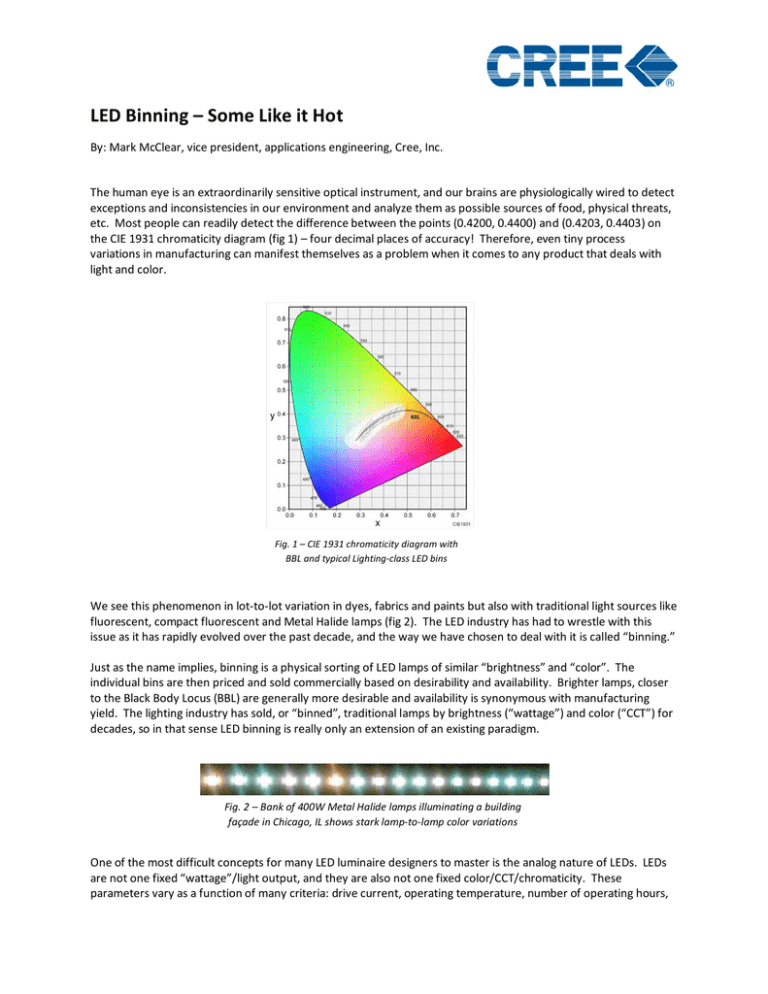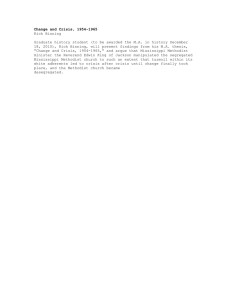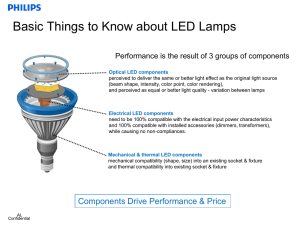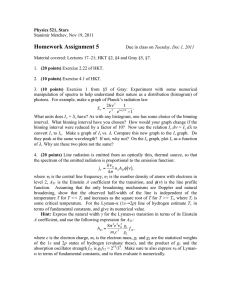
LED Binning – Some Like it Hot
By: Mark McClear, vice president, applications engineering, Cree, Inc.
The human eye is an extraordinarily sensitive optical instrument, and our brains are physiologically wired to detect
exceptions and inconsistencies in our environment and analyze them as possible sources of food, physical threats,
etc. Most people can readily detect the difference between the points (0.4200, 0.4400) and (0.4203, 0.4403) on
the CIE 1931 chromaticity diagram (fig 1) – four decimal places of accuracy! Therefore, even tiny process
variations in manufacturing can manifest themselves as a problem when it comes to any product that deals with
light and color.
Fig. 1 – CIE 1931 chromaticity diagram with
BBL and typical Lighting-class LED bins
We see this phenomenon in lot-to-lot variation in dyes, fabrics and paints but also with traditional light sources like
fluorescent, compact fluorescent and Metal Halide lamps (fig 2). The LED industry has had to wrestle with this
issue as it has rapidly evolved over the past decade, and the way we have chosen to deal with it is called “binning.”
Just as the name implies, binning is a physical sorting of LED lamps of similar “brightness” and “color”. The
individual bins are then priced and sold commercially based on desirability and availability. Brighter lamps, closer
to the Black Body Locus (BBL) are generally more desirable and availability is synonymous with manufacturing
yield. The lighting industry has sold, or “binned”, traditional lamps by brightness (“wattage”) and color (“CCT”) for
decades, so in that sense LED binning is really only an extension of an existing paradigm.
Fig. 2 – Bank of 400W Metal Halide lamps illuminating a building
façade in Chicago, IL shows stark lamp-to-lamp color variations
One of the most difficult concepts for many LED luminaire designers to master is the analog nature of LEDs. LEDs
are not one fixed “wattage”/light output, and they are also not one fixed color/CCT/chromaticity. These
parameters vary as a function of many criteria: drive current, operating temperature, number of operating hours,
phosphor technology, and the design of the LED lamp itself. Over the years, LED companies have more or less
arbitrarily selected standard drive currents and temperatures at which to bin their LED products and they publish
standard graphs to form a mathematical framework from which to calculate the performance of the LED lamp
under various operating conditions (fig 3).
Fig 3 – Typical LED data sheet mathematical framework for calculating Luminous flux at real-world conditions
The most common binning current for lighting-class LEDs is 350mA, but this too varies by LED lamp model and
manufacturer. LED lamps designed for general, non-lighting applications (so-called “High-Brightness” LED lamps)
are often binned at 20mA. Historically, nearly all LED lamp types have been binned at 25°C – the nominal ambient
temperature in the factory at the time of manufacture.
Cree became the first LED manufacturer to depart from the 25°C binning convention in 2011. The XLamp® MT-G,
released in February, 2011 and binned at 85°C, has subsequently been joined by five additional major Cree XLamp
platforms spanning thousands of lumens in flux range, single- and multi-chip arrays, standard and high voltage
options, and all ANSI chromaticity ranges, all binned at 85°C. This is important to note because this demonstrates
the considerable experience Cree has with “hot” binning, and thorough understanding of the strengths and
weakness of this approach from both the LED manufacturing and LED applications standpoints.
Fig 4 – XLamp MT-G: First LED
binned at 85°C
As the name implies, hot binning is binning the LED lamps at a higher temperature than the conventional 25°C.
The LED manufacturers who have decided to launch new products binned at an elevated temperature have
converged on 85°C as the new conventional binning temperature. 85°C binning is an arbitrary number, like 25°C
binning before it. Though arbitrary, 85°C has one advantage in that 85°C is a lot closer to the typical operating
temperature of many Solid State Lighting luminaires than 25°C.
Binning at 85°C makes the initial part of the design process slightly easier and more intuitive. For example, if a
designer were working on an LED system that required 1000 lumens at temperature (85°C), then 10 LED lamps
with a luminous flux of 100 lumen per LED binned at 85°C could be selected. This would make it easy to estimate
the performance of these LED lamps in this real-world situation (10 LEDs * 100 lm = 1000 lumens). On the other
hand, if the LEDs were binned at 25°C, the same 10 LED lamps would need to be binned at 114 lumens each and
de-rated per the mathematical framework in Figure 3 to arrive at the same 1000 lumen goal at the system level.
So, the good news is binning at 85°C makes the first-pass math more intuitive. The bad news is you still have to do
the same math if your system runs – or ever runs – at any temperature other than 85°C. Examples of this would be
outdoor luminaires (60-65°C is much more common) or freezer cases (20-25°C is typical) or downlights in Insulated
Ceilings or almost any retrofit bulb (often over 100°C). In each of these cases the value of binning at 85°C is lost
and the designer is back to doing the same math from a new mathematical framework where, arbitrarily, 85°C is
now set to equal 100%.
As we point out in the beginning of the article, LED lamp performance can vary considerably as a function of drive
current and temperature. Since an LED supplier can never know exactly what application an LED will be applied to
in the field, minimizing this variation across all possible drive currents and operating temperatures is of critical
importance. Minimizing this variation poses extreme design challenges to LED chip, phosphor technology, process
control, and package/lamp construction, and can also be very costly to implement.
There are hundreds of ways to cut corners on these LED lamp design parameters – this is one of the main
differences between lighting-class and “High Brightness” LEDs – and the results are often not readily apparent
from a typical LED data sheet. Hot binning can mask some of these issues even further, so hot binning can
become a useful technique for some LED manufacturers to mask enormous color variation of low quality LED
lamps over the full operating temperature and drive current range.
As an example, Figure 5 shows LED lamps from two different manufacturers – both binned at 85°C. In each case,
the LED lamps are driven starting at the binning drive current (350mA) and then stepped up to the data sheet
maximum (1500mA). The lamps are mounted on a thermal chuck to control the temperature from 35°C and
allowed to run up to 105°C at each current step and the chromaticity points (CCx, CCy;
see fig 5) were recorded.
Fig 5 – Hot binning masks massive color shift on some LEDs
From this we see that LED “A” has a very large – over 400K CCT – color variation as a function of the allowable
drive current and temperature range. We also note that this variation is more or less horizontal – across the CCT
range. LED lamp “A” actually changes color from the starting point in the 2700K ANSI quadrangle and crosses over
well into the 3000K ANSI quadrangle over the allowable operating range of the device. This would not be
considered acceptable color stability performance for most lighting applications.
Binning this lamp “hot” is convenient for the manufacturer of LED “A” because of the expectation that the lamp
will be used in or around 85°C in the field, and also near the nominal binning current of 350mA. If this is the case,
the customer of LED “A” will more or less get the flux and chromaticity that was ordered. A problem arises when
the actual application (e.g. – outdoor, freezer, downlights, and bulbs, as noted above) is almost any temperature
or drive current other than the “hot binning” parameters selected arbitrarily by the manufacturer of LED “A”.
LED “B”, on the other hand, shows only 31K variation across this same range of drive currents and temperatures,
and remains in the ANSI 3000K quadrangle under all data sheet operating conditions. This lighting-class LED lamp
system was engineered to manage the variation more in the vertical direction – along constant CCT lines –
regardless of end use application.
In summary, binning is how LED manufacturers reconcile manufacturing process variations and the exacting
sensitivities of the human vision system. Binning at 85°C is quickly becoming the convention in the Lighting-class
LED market segment because binning at elevated temperatures can make the initial design efforts a bit more
intuitive. There is no freedom from LED binning at this point in LED technology development, or from the math
that must be done in designing with these analog components in most real-world applications. Hot LED binning is
not always a magic fix-all designed to help LED system designers – it can also be a marketing fix-all designed to
help mask an underlying design weakness of an LED component.
© 2014 Cree, Inc. All rights reserved. For informational purposes only.
Cree® and XLamp® are registered trademarks of Cree, Inc.
This article appeared in Electronic Products Magazine, May, 2012
http://www2.electronicproducts.com/When_it_comes_to_binning_LEDs_some_like_it_hot-article-farc_cree_mqy2012html.aspx




